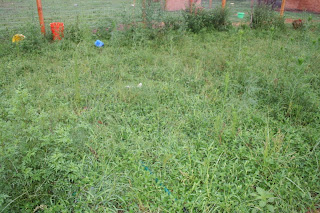We've been selling watermelon now for about a month and during that time we have collected quite a bit of watermelon rind. We've done lots of different things with it like feed it to the chickens or compost it, but I wanted to try to preserve some in a pickle form like my grandmother used to.
I stumbled across a recipe for watermelon rind preserves at Mad at Me, I set out to try to recreate it.
This is not a quick canning project! It takes 3 days to make this yummy preserve, but it is worth every minute of time you put in it.
Start by cutting your watermelon-You need one large watermelon to make this. When cutting the rind, be sure you get most of the red off and the outside hard green shell.
Cut the rind in either chunks or strips.
 Soak the rind for 24 hours in a mixture of 3/4 cup canning salt to one gallon water. I put a plate in the soaking pot on top of my watermelon to hold it down under the brine.
Soak the rind for 24 hours in a mixture of 3/4 cup canning salt to one gallon water. I put a plate in the soaking pot on top of my watermelon to hold it down under the brine.
On day two rinse the rind off really good and begin to prepare your syrup.
For the syrup you will need:
6 Cups sugar
4 Cups white vinegar
2 Cups brown sugar
4 lemons, cut into slices
4 Cups white vinegar
2 Cups brown sugar
4 lemons, cut into slices
1 Tablespoon whole cloves
1 Tablespoon whole allspice
4 to 6 sticks cinnamon, broken into halves
1 teaspoon mustard seed
1 Tablespoon whole allspice
4 to 6 sticks cinnamon, broken into halves
1 teaspoon mustard seed
Combine all the syrup ingredients in a saucepan and bring to a boil, then simmer for 5 minutes.
Put the rind back into a rinsed bowl and poor the syrup over them, cover tightly and let this sit for 24 hours.
The third day is canning day.
 Bring syrup mixture to a boil and ladle the rinds into prepared mason jars. Include some of the lemon slices, spices, and cinnamon sticks in each jar and enough syrup to fill jars.
Bring syrup mixture to a boil and ladle the rinds into prepared mason jars. Include some of the lemon slices, spices, and cinnamon sticks in each jar and enough syrup to fill jars.
Leave 1/2" head space in each jar.
Using a water bath, can each jar for 10 minutes.
These pickles need at least a week to sit after processing before they are ready to eat. We opened a jar a few days early and they were still quite strong. I will make sure I leave the others to sit for at least a week before opening them.
There are many recipes you can use the rinds in and I will post them as I try them. The rinds were a hit in our house and we will make sure that we have enough canned up to use throughout the year.
+(2).jpg)

+(2).jpg)
.jpg)







.jpg)
.jpg)
.jpg)
.jpg)
.jpg)
.jpg)




.jpg)

.jpg)


.jpg)
.jpg)
.jpg)
.jpg)
.jpg)
.jpg)
.jpg)
.jpg)
.jpg)
.jpg)
.jpg)








